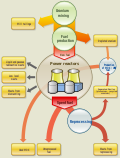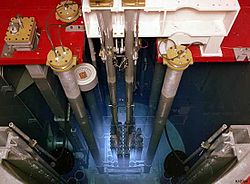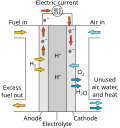Fuel temperature coefficient of reactivity is the change in reactivity of the nuclear fuel per degree change in the fuel temperature. The coefficient...
1 KB (168 words) - 11:09, 28 August 2024
including electric and magnetic properties of materials as well as reactivity. The temperature coefficient of most of the reactions lies between 2 and 3. Most...
12 KB (1,676 words) - 06:12, 8 December 2023
prompt negative fuel temperature coefficient of reactivity, meaning that as the temperature of the core increases, the reactivity decreases—so it is highly...
55 KB (6,900 words) - 10:02, 18 July 2025
the void coefficient (more properly called void coefficient of reactivity) is a number that can be used to estimate how much the reactivity of a nuclear...
11 KB (1,625 words) - 22:30, 22 April 2025
Uranium zirconium hydride (category Nuclear fuels)
prompt negative fuel temperature coefficient of reactivity, meaning that as the temperature of the core increases, the reactivity rapidly decreases...
2 KB (138 words) - 18:34, 29 May 2025
phenomenon driving the fuel temperature coefficient of reactivity also been used as a design consideration in high-temperature nuclear reactors. In principle...
7 KB (1,141 words) - 23:01, 13 April 2024
hydride (UZrH) fuel, which has a large, prompt negative fuel temperature coefficient of reactivity, meaning that as the temperature of the core increases...
14 KB (697 words) - 09:33, 6 July 2025
RBMK (section High positive void coefficient)
positive void coefficient was reduced from +4.5 β to +0.7 β, decreasing the likelihood of further reactivity accidents, at the cost of higher enrichment...
93 KB (10,722 words) - 20:13, 17 July 2025
Pressurized water reactor (section Fuel)
positive thermal coefficient of reactivity. This means reactivity and heat generation increases when coolant and fuel temperatures increase, which makes...
33 KB (4,322 words) - 00:29, 17 June 2025
on Doppler broadening or on negative void coefficient from a moderator. However, thermal expansion of the fuel itself can provide quick negative feedback...
26 KB (2,848 words) - 18:53, 24 May 2025
Critical mass (section Amount of fuel)
negative temperature coefficient of reactivity to indicate that its reactivity decreases when its temperature increases. Using such a material as fuel means...
20 KB (2,863 words) - 09:50, 30 June 2025
models. Negative-temperature-coefficient (NTC) thermistors have less resistance at higher temperatures, while positive-temperature-coefficient (PTC) thermistors...
32 KB (4,123 words) - 20:35, 18 July 2025
as for stationary fuel-cell applications and portable fuel-cell applications. Their distinguishing features include lower temperature/pressure ranges (50...
62 KB (8,028 words) - 10:30, 11 July 2025
operating temperature which results in longer start-up times and mechanical and chemical compatibility issues. Solid oxide fuel cells are a class of fuel cells...
76 KB (9,828 words) - 19:23, 22 May 2025
segregation and sintering of solid materials. The Tammann temperature is important for reactive compounds like explosives and fuel oxiders, such as potassium...
11 KB (1,130 words) - 19:59, 18 July 2025
Nuclear fusion (category Pages that use a deprecated format of the chem tags)
Glass "Temperature Measurements Of An Implosion Focus Archived 2012-07-20 at the Wayback Machine" Ion Flow and Fusion Reactivity, Characterization of a Spherically...
113 KB (12,226 words) - 04:19, 17 July 2025
double-layered PTFE-coated fiberglass dome. Because of its extreme non-reactivity and high temperature rating, PTFE is often used as the liner in hose assemblies...
59 KB (6,062 words) - 12:46, 21 July 2025
to the designers, the reactor will have a "large negative temperature reactivity coefficient", lacks pumps and valves, uses heat pipes for heat removal...
6 KB (549 words) - 15:18, 15 May 2025
Light-water reactor (category Wikipedia articles in need of updating from July 2015)
property, known as the negative temperature coefficient of reactivity, makes PWRs very stable. In event of a loss-of-coolant accident, the moderator is...
25 KB (3,329 words) - 00:26, 24 June 2025
Nuclear meltdown (redirect from Fuel meltdown)
lost, but moderation continues. This is termed a positive void coefficient of reactivity. The RBMK tends towards dangerous power fluctuations. Control...
56 KB (7,656 words) - 15:47, 14 June 2025
Nuclear chain reaction (redirect from Reactivity (nuclear))
calculate or use practically. Instead, a system's reactivity is quantified instead. The reactivity of a nuclear system is qualitatively described as the...
43 KB (6,139 words) - 04:48, 22 June 2025
properties i.e. low absorption cross-section, optimal constant reactivity, suitable Doppler coefficient, phase stability, chemical inertness, and compatibility...
71 KB (9,931 words) - 05:41, 2 July 2025
CANDU derived fuel bundles, the reactor design has a slightly positive Void coefficient of reactivity, the Argentina designed CARA fuel bundles used in...
16 KB (2,042 words) - 16:28, 17 July 2025
Calibration of shim rod vs. regulating rod Effect of fuel flow on reactivity Low-power measurement of reactor temperature coefficient Adjustment of chamber...
18 KB (2,187 words) - 23:07, 9 March 2025
Gas-cooled reactor (redirect from Prismatic fuel reactor)
capable in principle of using unenriched fuel but require online refueling to be viable power reactors. No void coefficient of reactivity as the coolant is...
6 KB (773 words) - 06:19, 30 June 2025
reactors are unstable against changes in temperature (there is a "positive temperature coefficient" in the reactivity of the core), and so are less inherently...
28 KB (4,307 words) - 21:42, 18 June 2025
Advanced heavy-water reactor (section Fuel cycle)
probability of this occurrence through: negative reactivity coefficients, low power density, low excess reactivity in the core and proper selection of material...
20 KB (2,114 words) - 08:33, 18 April 2025
Fast-neutron reactor (section Fuel)
an excess of fuel is inserted with reactivity control mechanisms, such that the reactivity control is inserted fully at the beginning of life to bring...
57 KB (7,498 words) - 10:36, 20 July 2025
uranium-233 fluoride fuel dissolved in it. The MSRE had a negative temperature coefficient of reactivity: as the FLiBe temperature increased, it expanded...
25 KB (3,350 words) - 18:10, 8 May 2025
MSBR design), less fuel salt means better moderation and thus more reactivity and an undesirable positive temperature coefficient. Stable coolant. Molten...
116 KB (14,402 words) - 22:51, 1 July 2025




















